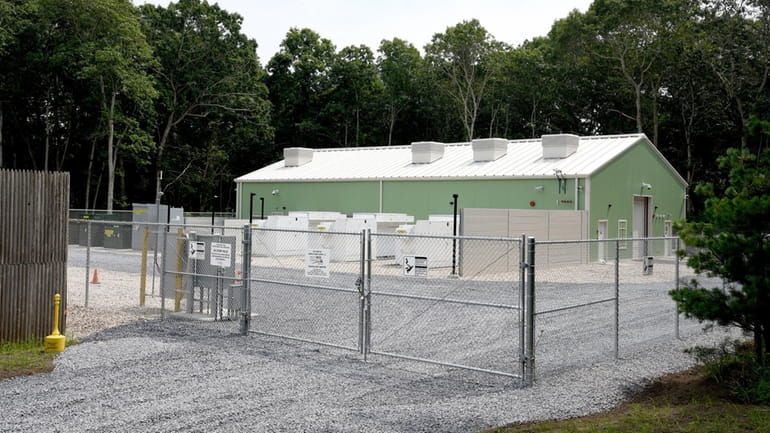State: No harmful toxin levels after battery storage fires

A 5-megawatt battery storage unit, located at a substation in East Hampton in 2018. Credit: Veronique Louis
Fires at three large battery-storage facilities, including one in East Hampton, resulted in “no harmful levels of toxins detected” in their aftermath, according to preliminary findings by a state task force released Thursday.
But critics of placing the barn-sized lithium-ion facilities in residential neighborhoods suggested the state's report raised more questions than it answered, and some are bracing for fights across the region after Newsday reported plans for dozens of the facilities across Long Island and the state in coming years. At least two Long Island towns, Southold and Southampton, already have moratoriums to block new battery storage facilities, and others are reported to be considering similar measures.
Gov. Kathy Hochul convened an Inter-Agency Fire Safety Working Group after three separate fires this summer at the facilities, which store electricity and are an important pillar of the state’s plan for a carbon-free electric grid by 2040.
In a news release, Hochul’s office noted there were no reported injuries from the fires, and that “available analyses of air quality, soil or water data collected” days after found no harmful levels of toxins. The group also found “no evidence of significant off-site migration of contaminants associated with the fires.”
Among the fires under review was one at a 5-megawatt battery plant in East Hampton on May 31 that has taken the facility out of operation until June, officials have said. Internal systems put out the fire but caused extensive damage to the plant that requires complete replacement.
In an analysis about the East Hampton fire provided to Newsday by the state Department of Environmental Conservation, plant co-owner NextEra Energy noted that the type of fire that occurred at the Cove Hollow Road facility has the potential “to generate intense heat, which can make it easy for the fire to spread, as well as release fumes.”
To quell the fire, which can be “incredibly hard to extinguish due to the intense heat generated,” the facility maintained an emergency sprinkler system that kept running for approximately 30 hours after the blaze started, the report said.
“This resulted in water inside the building eventually exiting the building and migrating to the adjacent dirt road to the southwest of the compound.”
While the samples detected aluminum, arsenic, barium, beryllium, calcium, chromium, copper, iron, lead, magnesium, manganese, mercury, nickel, potassium, silver, vanadium and zinc, the amounts were below “New York Soil Cleanup objects for commercial use” and “in most cases residential soil cleanup objectives.”
The report added: “It is apparent that there are no adverse impacts to the soils as a result of the battery fire discharge water,” and the owners recommended that “no further investigation or remedial activities” were needed. They requested the status of the spill be closed.
The analysis also discusses the inability of some contractors to test for lithium, though ultimately they did test for lithium.
One vocal opponent of a state-approved plan to build a 110-megawatt battery in a neighborhood in Holtsville near existing power and fuel facilities, took issue with the state's preliminary findings.
“I think the study was rushed and the lack of public transparency, involvement, lack of outreach to the local elected officials, calls into question the full scope and validity of the working group’s results,” said Gabrielle Corso, who is leading a group of residents in opposition to the Holtsville battery plant.
Corso said she’d like to know what specifically is being cleaned up at the site in East Hampton, where the May fire occurred. “I’d like to know what they measured” to justify its finding of “no harmful levels of toxins,” Corso said.
Concerns caused by that fire and separate fires at plants in Jefferson and Orange counties have led to protests by neighborhood groups at proposed facilities on Long Island. The Orange County fire on school grounds in Warwick kept emergency crews working for days, Newsday reported, while a separate large fire near Watertown in Jefferson County produced smoke that officials warned residents to avoid inhaling.
LIPA and the state are planning dozens of such facilities to store energy — up to 6,000 megawatts statewide — to replace small local fossil-fuel fired peak power plants which must be retired by 2040. The batteries can store energy from a coming generation of offshore wind and solar power plants, then make that power available when the wind isn’t blowing or the sun isn’t shining.

